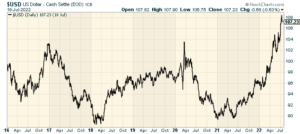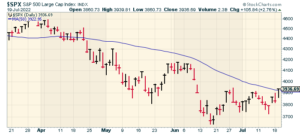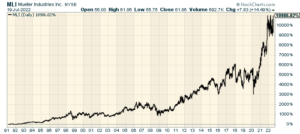CWS Market Review – July 19, 2022
(This is the free version of CWS Market Review. If you like what you see, then please sign up for the premium newsletter for $20 per month or $200 for the whole year. If you sign up today, you can see our two reports, “Your Handy Guide to Stock Orders” and “How Not to Get Screwed on Your Mortgage.”)
Inflation-Phobia Stalks Wall Street
The stock market is still spooked by last week’s CPI report. Some observers thought we might see some cooling off of inflation. Well, that was not the case. Over the last year, inflation is running at 9.1%.
Inflation falls particularly hard on lower-income consumers and we’re already seeing it alter consumer behavior. According to the latest data, consumers are cutting back on purchases at the grocery store. Last month, for example, the price for a pound of white bread got to $1.69. That’s up 12% from last year. A pound of wheat bread got to $2.22, which is a record. In many parts of America, gasoline recently broke $5 per gallon, although it’s been drifting lower recently.
While inflation is tough for consumers, it also wreaks havoc on the financial markets. The data shows that inflation is fairly benign until it gets to about 5%. Above that, stocks start to feel the squeeze, and right now, we’re nearly double that rate. This is why everyone is on edge.
Following last week’s inflation report, there was a brief period where traders were expecting a full 1% increase from the Federal Reserve at next week’s FOMC meeting. However, the Wall Street Journal had a story over the weekend which said that a 0.75% increase is much more likely. As we know, the Fed pays close attention to inflation expectations. A recent survey of inflation expectations dropped to its lowest level in a year.
Still, that hasn’t calmed folks down. Despite the WSJ article, traders are currently placing 35% odds on a 1% hike. I doubt that will happen, but it shows how unnerved traders are. Even if we only get a 0.75% hike next week, we’ll probably get another 0.75% increase in September. Before the end of the year, it’s very possible that short-term interest rates will be 2% higher.
The higher rates are already having an impact. This morning, we got a report that housing starts fell for the second month in a row. Housing starts are now at a nine-month low. The bright spot, if there is one, is that homebuilders are still busy working down their backlog of unfilled orders.
The U.S. Dollar’s “Doom Loop”
Another side effect of higher interest rates is the soaring U.S. dollar. Recently, the dollar reached parity against the euro for the first time in 20 years. The dollar has also reached an all-time high against the Indian rupee. It also reached a high against the yen.
There’s even been talk of a possible “doom loop” involving the U.S. dollar. Simply put, that means that the strong dollar causes economic weakness which in turn leads to an even stronger dollar, which leads to more weakness. The cycle then repeats itself ad nauseam.
In normal times, that’s an easy cycle to break. The Fed would simply lower interest rates and weaken the dollar, but it can’t do that now with inflation heading toward 10% per year.
Here’s the Dollar Index. Notice how strongly it has rallied over the last year.

This angle gets more interesting because the European Central Bank meets on Thursday and is expected to raise interest rates for the first time in 11 years. The ECB’s President, Christine Lagarde, has signaled that the ECB will hike by 0.25%, but some economists think it will be a 0.5% increase.
The strong dollar is having an impact almost everywhere. Obviously, the Fed is keeping its eye on the foreign exchange market, but we’re seeing its impact within U.S. companies. While the dropping euro is great for U.S. tourists, it’s terrible news if you’re a big tech stock.
I’ll give you a perfect example. Yesterday afternoon, IBM (IBM) reported decent results for its Q2. For the quarter, IBM made $2.31 per share which was four cents better than Wall Street’s consensus. The company also said that it shut down its operations in Russia.
But neither of those issues were the big story. Instead, IBM said it expects to take a 6% hit to its revenues thanks to the strong dollar. That’s a big bite. IBM’s earlier projection had been for a hit of 3% to 4%. Q2 revenue was hit by $900 million thanks to the greenback. We’re talking about a $3.5 billion bite this year. Despite a good quarter, the dollar news dominated everything, and it’s likely to get worse. Shares of IBM fell 5.25% today.
This is just the beginning. The strong dollar is going to beat up several more tech stocks this year. We just don’t know yet which ones and how much.
Earnings Season Is Heating Up
This is also the start of earnings season. Only about 9% of the S&P 500 has reported so far, so it’s too early to draw any large conclusions. The “beat rate,” meaning how many firms have reported earnings better than expected, is running at 65%. That may sound good, but it’s well below the 77% rate that Wall Street has averaged over the past five years.
By the way, you read that correctly. Historically, a large majority of companies beat expectations, but those are the official expectations. The expected expectations may not be the same as the official expectations. Some companies are very skillful in managing what Wall Street analysts say. It’s all about expectations.
Wall Street had been nervous going into this earnings season. A recent survey by Bank of America showed wide-spread pessimism from investors. Recession expectations are at their highest levels since the pandemic.
Fortunately, many of the earnings reports we got today relieved investors. The dollar also fell some today which probably helped the bulls. The S&P 500 closed higher by 2.76%. This was the best day for stocks in nearly one month. For the first time since April 20, the S&P 500 closed above its 50-day moving average. That can often be a good omen, but I encourage you not to read too much into it.

The Nasdaq Composite also had a very good day. The index closed higher by 3.1%, but the really strong index today was the Russell 2000. The small-cap index rallied 3.5% today.
Here’s a great stat from Callie Cox: ten times this year, the S&P 500 has rallied more than 1% during the day only to finish lower on the day by the closing bell.
Shares of Johnson & Johnson fell over 1% today after the company beat earnings but lowered its guidance for the rest of this year. Lockheed Martin missed expectations, but the stock rallied 0.8% today.
In after-hours trading, shares of Netflix traded higher by 8%. The good news for Netflix is that it “only” lost 970,000 subscribers last quarter. Wall Street had been expecting a loss of two million. Once again, it’s all about expectations.
Tomorrow, we’ll get our first Buy List earnings report when Abbott Labs (ABT) releases its Q2 earnings report. The results will come out before the opening bell.
Previously, the company told us to expect full-year earnings of $4.70 per share. For Q2, Wall Street expects earnings of $1.12 per share. Not only am I expecting Abbott to beat Wall Street’s view for Q2, but I think there’s a good chance they’ll raise their full-year guidance as well.
Mueller Industries Soars 14.5%
In June 2021, I featured a small stock for you called Mueller Industries (MLI). Muller is one of those little stocks that’s virtually ignored by Wall Street. The company has a great long-term track record, yet no Wall Street analysts follow it.
Mueller is a leading manufacturer of copper, brass, aluminum and plastic products. This is a classic small-cap cyclical stock. Once you realize the scope of their business, you understand that the use of Mueller’s products is seemingly endless. Mueller makes everything from copper tubing and fittings to brass and copper alloy bars and refrigeration valves.
You can find Mueller most anywhere. Some of the companies that rely on Mueller are in sectors like plumbing, heating, air conditioning, refrigeration, appliance, medical, automotive, military and defense, marine and recreational. Mueller’s operations are located throughout the United States and in Canada, Mexico, Great Britain, South Korea, and China.
Mueller has about 5,000 employees and it’s based in Collierville, Tennessee. The company’s operations are divided among three divisions: Piping Systems, Industrial Metals, and Climate.

I bring up Mueller because the company released an outstanding earnings report. I can’t tell if it beat expectations or not because no one follows it, so there are no expectations. For Q2, Mueller made $3.65 per share. That’s up from $1.92 per share for last year’s Q2. Mueller has zero net debt.
The shares rallied 14.5% today. Over the last 30 years, Mueller is up more than 100-fold, and no one on Wall Street follows them. Sigh.
That’s all for now. I’ll have more for you in the next issue of CWS Market Review.
– Eddy
By the way, if you haven’t already signed up for our premium newsletter, please join us today. It’s $20 per month or $200 for the entire year.
Posted by Eddy Elfenbein on July 19th, 2022 at 4:23 pm
The information in this blog post represents my own opinions and does not contain a recommendation for any particular security or investment. I or my affiliates may hold positions or other interests in securities mentioned in the Blog, please see my Disclaimer page for my full disclaimer.
- Tweets by @EddyElfenbein
-
-
Archives
- May 2024
- April 2024
- March 2024
- February 2024
- January 2024
- December 2023
- November 2023
- October 2023
- September 2023
- August 2023
- July 2023
- June 2023
- May 2023
- April 2023
- March 2023
- February 2023
- January 2023
- December 2022
- November 2022
- October 2022
- September 2022
- August 2022
- July 2022
- June 2022
- May 2022
- April 2022
- March 2022
- February 2022
- January 2022
- December 2021
- November 2021
- October 2021
- September 2021
- August 2021
- July 2021
- June 2021
- May 2021
- April 2021
- March 2021
- February 2021
- January 2021
- December 2020
- November 2020
- October 2020
- September 2020
- August 2020
- July 2020
- June 2020
- May 2020
- April 2020
- March 2020
- February 2020
- January 2020
- December 2019
- November 2019
- October 2019
- September 2019
- August 2019
- July 2019
- June 2019
- May 2019
- April 2019
- March 2019
- February 2019
- January 2019
- December 2018
- November 2018
- October 2018
- September 2018
- August 2018
- July 2018
- June 2018
- May 2018
- April 2018
- March 2018
- February 2018
- January 2018
- December 2017
- November 2017
- October 2017
- September 2017
- August 2017
- July 2017
- June 2017
- May 2017
- April 2017
- March 2017
- February 2017
- January 2017
- December 2016
- November 2016
- October 2016
- September 2016
- August 2016
- July 2016
- June 2016
- May 2016
- April 2016
- March 2016
- February 2016
- January 2016
- December 2015
- November 2015
- October 2015
- September 2015
- August 2015
- July 2015
- June 2015
- May 2015
- April 2015
- March 2015
- February 2015
- January 2015
- December 2014
- November 2014
- October 2014
- September 2014
- August 2014
- July 2014
- June 2014
- May 2014
- April 2014
- March 2014
- February 2014
- January 2014
- December 2013
- November 2013
- October 2013
- September 2013
- August 2013
- July 2013
- June 2013
- May 2013
- April 2013
- March 2013
- February 2013
- January 2013
- December 2012
- November 2012
- October 2012
- September 2012
- August 2012
- July 2012
- June 2012
- May 2012
- April 2012
- March 2012
- February 2012
- January 2012
- December 2011
- November 2011
- October 2011
- September 2011
- August 2011
- July 2011
- June 2011
- May 2011
- April 2011
- March 2011
- February 2011
- January 2011
- December 2010
- November 2010
- October 2010
- September 2010
- August 2010
- July 2010
- June 2010
- May 2010
- April 2010
- March 2010
- February 2010
- January 2010
- December 2009
- November 2009
- October 2009
- September 2009
- August 2009
- July 2009
- June 2009
- May 2009
- April 2009
- March 2009
- February 2009
- January 2009
- December 2008
- November 2008
- October 2008
- September 2008
- August 2008
- July 2008
- June 2008
- May 2008
- April 2008
- March 2008
- February 2008
- January 2008
- December 2007
- November 2007
- October 2007
- September 2007
- August 2007
- July 2007
- June 2007
- May 2007
- April 2007
- March 2007
- February 2007
- January 2007
- December 2006
- November 2006
- October 2006
- September 2006
- August 2006
- July 2006
- June 2006
- May 2006
- April 2006
- March 2006
- February 2006
- January 2006
- December 2005
- November 2005
- October 2005
- September 2005
- August 2005
- July 2005
 Eddy Elfenbein is a Washington, DC-based speaker, portfolio manager and editor of the blog Crossing Wall Street. His
Eddy Elfenbein is a Washington, DC-based speaker, portfolio manager and editor of the blog Crossing Wall Street. His